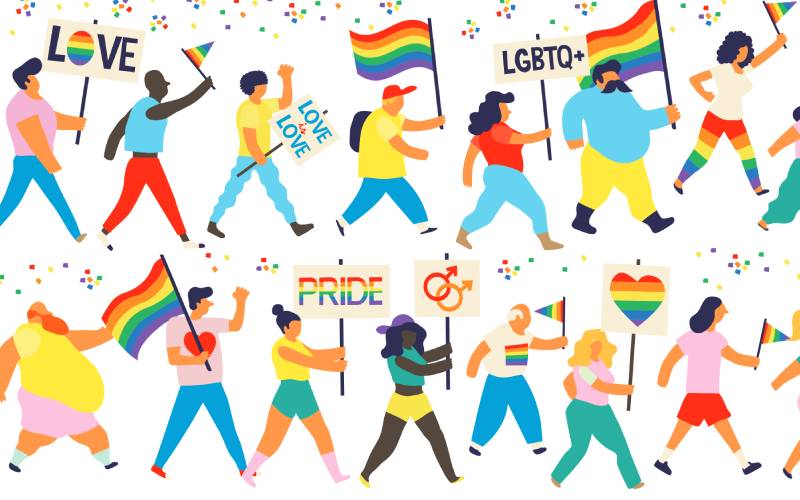It’s Pride Month, filled with parades and celebrations across the US and around the world. But how are LGBTQIA+ employees (who identify as lesbian, gay, bisexual, transgender [trans], queer, intersex, asexual and other gender identities) faring in your workplace? Let’s dive deep into this blog about diverse recruiting, which reveals five ways to better attract, hire and retain LGBTQIA+ employees.
Here’s a quick recap of Part 1:
1. Get real: Take stock of current workforce diversity. Many organizations may consider themselves to be LGBTQIA+ friendly, with a culture that supports and respects gender-diverse employees. What employees experience, however, may be quite different. Given the potential disconnect between corporate perceptions and reality, it may be the right time to consider a third-party evaluation of LGBTQIA+ inclusion and diversity efforts.
2. Take a closer look: Review existing policies, processes and HR infrastructure. Diversity, equity and inclusion (DE&I) programs will fall flat unless intention is coupled with action. Take a fresh look at eliminating bias from recruitment, providing equal benefits for all employees, and stamping out discrimination through policy. AI-driven tools like Textio can help make sure messaging is on point.
3. Seek and find: Proactively search for LGBTQIA+ talent. Reach beyond the usual demographics to include LGBTQIA+ job boards, and use job ads to explicitly state the organization’s commitment to gender-diverse inclusivity. Examine shortlisting, interviewing and hiring stages, again considering third-party expertise.

Now, two points on retention:
4. Lead by example: Train your workforce to be more inclusive.
In June 2020, McKinsey & Co. published “How the LGBTQ+ community fares in the workplace,” based on research the firm conducted in 2019, in conjunction with LeanIn.Org. As more companies implement post-pandemic return to office (RTO) plans, consider the ramifications of these illustrative findings:
- LGBTQ+ women are more than twice as likely as straight women to feel as though they cannot talk about themselves or their life outside work — and more likely than straight women or LGBTQ+ men to report they feel as though they need to provide more evidence of their competence.
- LGBTQ+ women are also the most likely to say they have reported microaggressions to their company — alerting managers to what can become legally sensitive work-culture issues that affect all women, even if straight women may be less aware of them. These include, for example:
- Pressure to play along. LGBTQ+ women are almost twice as likely to feel the pressure to “play along” with sexual discussion, humor, or actions than their straight-women and male-LGBTQ+ counterparts.
- Targets of sexist jokes. Half of LGBTQ+ women hear sexist comments or jokes about their gender while at work—1.5 times more than straight women and 2.6 times more than LGBTQ+ men.
- Targets of sexual harassment. More than half of LGBTQ+ women report having experienced sexual harassment over the course of their career, 1.4 times more than straight women and 1.9 times more than LGBTQ+ men.
Companies can take steps to stamp out inappropriate behavior by reinforcing and promoting their commitment to diversity and inclusion. Organization-wide conscious inclusion training can be a strong focal point, teaching employees how to recognize and respond to inappropriate behavior. This training can make employees aware of:
- What anti-LGBTQ+ discrimination and abuse look like.
- Sensitivity toward trans and gender-diverse colleagues, including the proper use of pronouns and names.
- How to challenge and deal with anti-LGBTQIA+ attitudes.
- Internal LGBTQIA+ networking opportunities.
As with any other culture initiative, executive leadership must set the tone for acceptable behavior with decisive and visible action to promote it. On the front lines, managers also must have the proper training to enforce policy that protects all from discrimination and abuse. Create an employee council to provide a voice and bolster the impact of Inclusion & Diversity (I&D) policies and initiatives.
Finally, training must be followed up with a safe reporting option to investigate and correct inappropriate behavior. Depending on the size of your organization, consider the addition of an I&D role or appending these responsibilities to an existing job profile.
Make sure you\'re prepped for success with our 2024 ultimate guide to diversity hiring.
Is DE&I a Priority for You in 2024?
5. Be proud and loud: Show your corporate Pride.

There are many opportunities to showcase public support of the LGBTQIA+ community, during Pride month and throughout the year. Burnish your employer brand by:
- Demonstrating public support – candidates prefer inclusive workplaces.
- Celebrating Pride Month on your social media channels, highlighting LGBTQIA+ employees and their contributions.
- Sponsoring and/or participating, as a company, in Pride events or parades.
- Sharing, in social media channels and recruiting materials, employee stories about how an inclusive and diverse atmosphere makes them feel.
Beyond celebrating Pride Month with rainbows galore, it’s important to remember that actions always speak louder than words. Gender-diverse inclusion efforts can’t be relegated to just a single month out of the year. Take part in LGBTQIA+ charities, causes and community centers, making these efforts part of your organization’s annual corporate social responsibility (CSR) calendar. And always remember: authenticity is key. Companies can’t “fake it ‘til they make it” on this important issue.
Happy Pride Month!
While implementing new initiatives can be overwhelming, there are a lot of resources and support available for those interested in diversity recruiting .Request a demo today to learn about Joveo’s inclusive sourcing and recruiting solutions. And follow us on Twitter and LinkedIn, where we’re always working to help you get the most out of your recruitment advertising.














